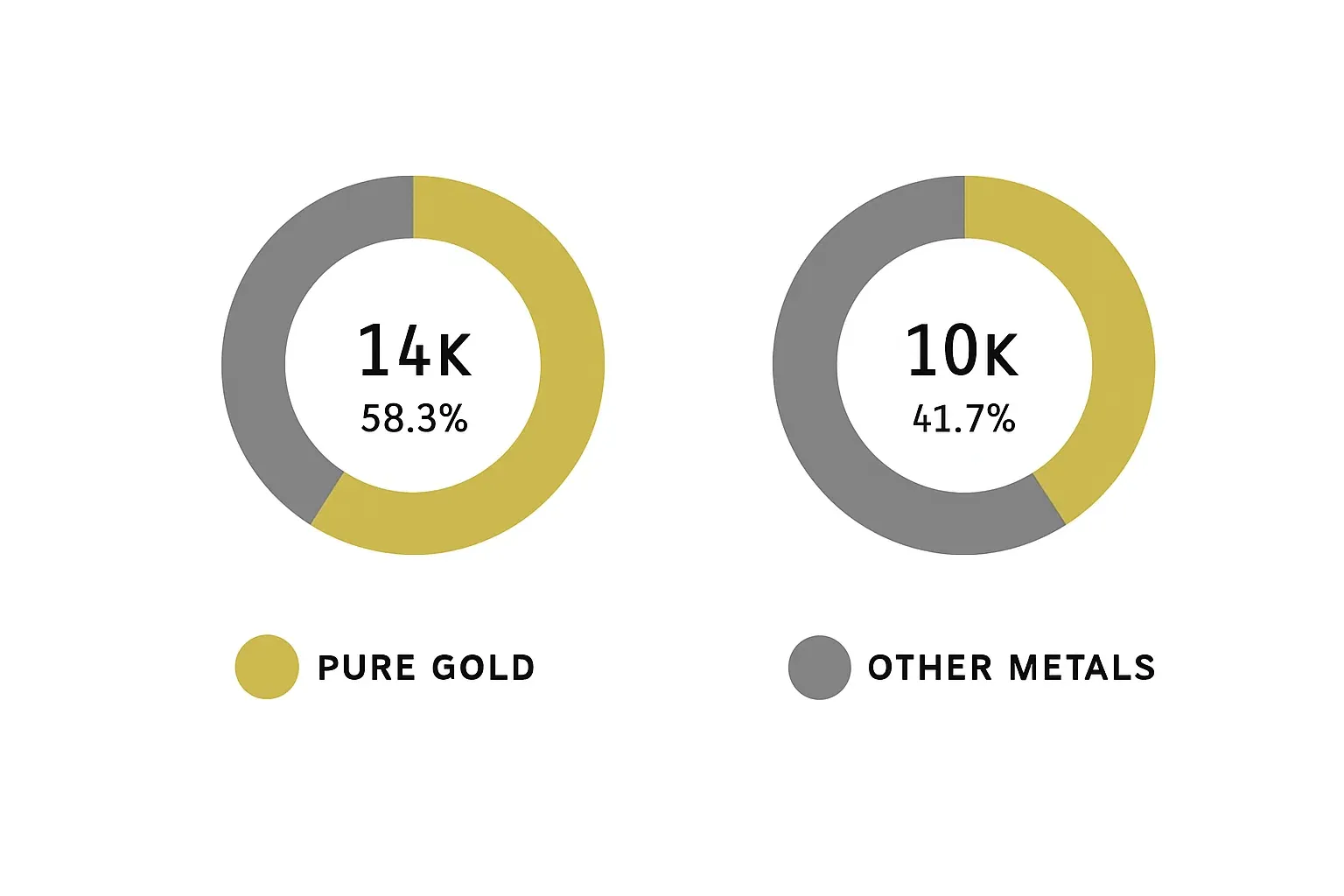Latest Designs for the New Year collection...
Shop NowAyaani Diamonds - AhmedabadChandigarhDelhiJodhpurMathuraRaipurSuratAhmedabad
No products found.
No products found.

07 November 2025
When it comes to gold jewellery, one question often pops up: 10K vs 14K gold, what’s the difference, and which one should you choose? While both shine beautifully, their composition, durability, and price can influence your decision.
Let’s explore how these gold types differ and how AYAANI’s Lab Grown Diamond Jewellery, available in 9K, 14K, and 18K gold, offers the best of both worlds.
Before we compare 10K and 14K, let’s understand the term “karat” (K).
A karat measures gold’s purity on a scale of 24.
The rest of the alloy is made of metals like silver, copper, zinc, or nickel to enhance durability and colour.
With 10K gold, the composition is almost five parts pure gold to seven parts alloy, specifically 41.7% gold against 58.3% other metals.. Its strength and resistance to scratches make it a top choice for budget-friendly jewellery. However, because it contains less gold, its yellow tone is slightly paler compared to higher-karat golds.
However, if you have sensitive skin, 10K may cause irritation due to its higher alloy content.
14K gold features 58.3% pure gold and 41.7% alloy metals, a sweet spot between durability and luxury. It’s less prone to tarnish than 10K gold, yet strong enough for daily wear.
Its richer golden hue makes it the go-to choice for people who love a classic, luxurious finish.
Feature | 10K Gold | 14K Gold | Jeweller’s Insight/Notes |
Gold Purity | 41.7% pure gold (10 parts gold, 14 parts alloy metals) | 58.3% pure gold (14 parts gold, 10 parts alloy metals) | 14K is more valuable and richer in gold content. |
Karat Stamp | Marked as “10K” or “417” | Marked as “14K” or “585” | Always check the hallmark for authenticity. |
Colour (Yellow/White/Rose) | Slightly paler or more silvery yellow; white gold appears more whitish | Richer, warmer yellow tone; white gold slightly creamier | 14K has a more “luxury” appearance preferred for fine jewellery. |
Durability/Hardness | Very durable, harder metal due to higher alloy content | Softer than 10K but still durable for daily wear | 10K resists scratching better, ideal for rugged wear. |
Tarnish Resistance | Less resistant; may dull or tarnish over time | Better resistance; maintains shine longer | 14K gold retains lustre with minimal maintenance. |
Skin Sensitivity/Allergies | May cause irritation (more alloy metals like nickel, zinc, copper) | Gentler on skin (less alloy content) | 14K is preferred for sensitive skin customers. |
Colour Matching with Stones | Slightly less vibrant backdrop for gemstones | Enhances gemstone brilliance and colour | Jewellers prefer 14K for diamonds and colored stones. |
Weight Feel | Slightly lighter (more alloy) | Slightly heavier (more gold content) | 14K pieces feel denser and more luxurious. |
Maintenance | Requires more frequent polishing | Easier to maintain shine | Professional cleaning every 6–12 months is recommended. |
Price/Cost | Less expensive (lower gold content) | Higher price (more gold content) | 14K generally costs 30–60% more than 10K. |
Resale Value | Lower resale value | Better resale/pawn value | 14K is a stronger investment metal. |
Common Uses | Budget jewellery, men’s bands, casual wear, large fashion pieces | Engagement rings, wedding jewellery, luxury everyday wear | 14K is the most popular karat in the market. |
Workability for Jewellers | Harder to resize or repair (more brittle) | Easier to solder, resize, and set stones | 14K offers better craftsmanship flexibility. |
Overall Appearance | Slightly duller and lighter | Brighter and richer colour | 14K looks closer to 18K gold in tone. |
Best For | Cost-conscious buyers, rugged daily use | Fine jewellery, special occasions, long-term value | Depends on the budget and lifestyle. |
Lab grown diamonds are redefining luxury; they’re ethical, eco-friendly, and identical to mined diamonds in brilliance and hardness.
AYAANI combines the modern beauty of lab-grown diamonds with responsibly sourced gold alloys, available in 9K, 14K, and 18K options.
This allows you to customise your sparkle according to your budget and lifestyle, without compromising on ethics or aesthetics.
Pro Tip from AYAANI: 14K gold offers the perfect harmony of purity, durability, and affordability, making it the ideal base for sustainable diamond jewellery.
If you’re active, on a budget, or want a sturdy piece for daily wear, 10K gold is a smart pick.
If you prefer richer colour and higher prestige, 14K gold is your match.
AYAANI’s jewellery in 9K, 14K, and 18K gold merges timeless design with ethical craftsmanship. Whether it’s a diamond pendant or an engagement ring, you’ll find beauty that lasts and cares for the planet.
When comparing 10K vs 14K gold, it all comes down to your lifestyle and style preference. For timeless brilliance, everyday durability, and sustainable elegance, AYAANI’s Lab Grown Diamond Jewellery, crafted in 9K, 14K, and 18K gold, is the ultimate choice.
Make your next piece of jewellery not just beautiful, but meaningful.
1. Is 14K gold worth the extra cost compared to 10K gold?
Yes, 14K gold offers a richer appearance, better resale value, and is less likely to irritate your skin.
2. Which is more durable, 10K or 14K gold?
10K gold is harder, but 14K offers the best balance between strength and elegance.
3. Does 10K gold tarnish easily?
It’s resistant to scratches but can tarnish faster than 14K gold.
4. Can you wear 14K gold every day?
Absolutely! 14K gold is durable enough for daily wear and ideal for diamond jewellery.
5. Which gold is better for engagement rings?
14K gold, its lustre and purity beautifully enhance diamond brilliance.
6. Why does AYAANI offer 9K, 14K, and 18K gold options?
To cater to diverse needs, 9K for affordability, 14K for balance, and 18K for luxury.
© 2025, AYAANI DIAMONDS. Developed & Maintained By Nothing Info, Designed & Marketing By Kyros Solution.